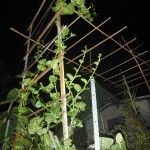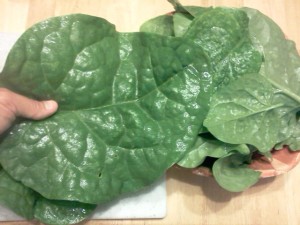 Malabar spinach is an answer to one of my many garden-based prayers, the most common request being “Please give me SOMETHING organic, besides fire, to eliminate these pickle worms”. Not bad, one line in and already wandering off-topic!
Malabar spinach is an answer to one of my many garden-based prayers, the most common request being “Please give me SOMETHING organic, besides fire, to eliminate these pickle worms”. Not bad, one line in and already wandering off-topic!
My wife likes veggies. Me, not so much, at least not as much as she does. I’m a Hillbilly carnivore, I eat ANYTHING made of meat. Hell, my dad had a Jeep with a welded pipe bumper he would use to drive INTO the deer…so we could eat them. (Look, two-for two on the paragraph-to-tangent score!) However, I DO appreciate growing my own veggies, and don’t mind eating them as a complimenting dish…as long as it’s served with meat of some sort.
Except for cooked spinach. Love the stuff. Could, have, and probably will again eat an entire can, cold. Almost Popeye-like. But it won’t grow here very well, particularly in the summer, the traditional time to grow it, at least from my childhood. I’ve been hoping to find a decent alternative that will grow here, and was pleased with sweet potato leaves (check back later this week fora post about it, and will hotlink it once it’s written) as far as a cooked substitute goes. But Malabar spinach hit the mark….then hit it again, splitting the first arrow.
It’s so tasty I’m tempted to go outside right now, snag a few leaves and cook it up. For Father’s day, the wife and kids asked what I wanted for dinner, their treat, and my reply was a rib eye steak and some Malabar spinach cooked in bacon grease with garlic and some bacon crumbled on top. Can you tell that I like it? Well, that and bacon, too. 🙂
Malabar spinach is a perennial vine found in the tropics where it is widely used as a leaf vegetable. It is native to tropical Asia, probably originating from India or Indonesia, and, thankfully, is extremely heat tolerant. grown throughout the tropics as a perennial and in warmer temperate regions as an annual. There are two main species of Malabar spinach: Basella alba, which has green stems and thick fleshy leaves, and Basella ruba which has red stems. The mucilaginous texture is especially useful as a thickener in soups and stews, similar to okra. (Don’t tell my wife, she HATES okra.)
More details:
- It is hardy in zones 7, 8, 9, 10, and 11.
 It grows up to 15 feet in height and will spread out 5 – 10 feet.
It grows up to 15 feet in height and will spread out 5 – 10 feet.- Light exposure is full or partial sun.
- It likes well drained, moist soil.
- It is a low maintenance plant with very little diseases or insects that affect it.
- Does best when trained to grow on a trellis or poles, harvesting the leaves from the bottom of the plant and let the top keep growing upward
- Goes well fried in bacon grease, but then what doesn’t?
 Preparation : Leaves can be eaten raw, though are considered “slimy or slippery”, not as bad as okra, but as I’ve said before, similar. Cooking is always a great option, and any recipe calling for “regular” spinach can work with Malabar spinach. The stems can be treated like asparagus, and are quite a surprise as to how large the stems can grow, yet still remain tender.
Preparation : Leaves can be eaten raw, though are considered “slimy or slippery”, not as bad as okra, but as I’ve said before, similar. Cooking is always a great option, and any recipe calling for “regular” spinach can work with Malabar spinach. The stems can be treated like asparagus, and are quite a surprise as to how large the stems can grow, yet still remain tender.In my Florida gardening research, I had heard a couple references regarding the lovely vine, but had never been able to find some to try out. At a recent plant sale at South Fork HS, I found a vendor with three unlabeled plants in 3-inch pots at $1 per plant that I recognized immediately from my research. I handed over a dollar bill, ripped off a leave and tasted it. Grabbing two more dollar bills, the others joined my pile of “try me” plants I intended to give a shot at growing. For $3, I was willing to give it a more intensive taste test.
Planting them in a row, about 15 inches between plants, I hoped to have them take over the trellis I placed next to them. For the first few days, nothing amazing happened. Then, as the heat increased due to summer bearing own on us, I notice the plants would grow as much as 6 inches per day. Awesome! It seems that being tropical in origin, the hotter it gets, the better it grows. I soon had more plant than I had trellis, at least on one side.
Throughout this growth period, from ground level to 8 ft, my family was able to have 4 or 5 batches of cooked spinach, all of us enjoying it. I’ve since added a horizontal trellis to allow the vines to grow across , providing some shade for the black cherry- and Everglades tomatoes below. I’ve also taken some cuttings to try to establish a few more plants to increase my production. I’ve pressure canned collard greens before, so would LOVE to try to can some Malabar spinach.
And yes, I’d eat it cold, right out of the jar!

db
Tomorrow, Thai Yard-Long green beans.
PS – Please “like” FloridaHillbilly on Facebook, subscribe to my feed, and tell your friends! The more folks involved in growing some of their own food, the less likely they are to turn into zombies and eat your brains!
Got to get some – but where db, where? Malabar spinach – where you be?( that’s Kentucky speak)
I’ll try getting some cutting to take root for you…and find you the phone number for the nursery where I purchased mine.
I would love some cuttings or the name/number from South Fl that carries them-please. Daniela
I simply bought seeds from ebay 😛